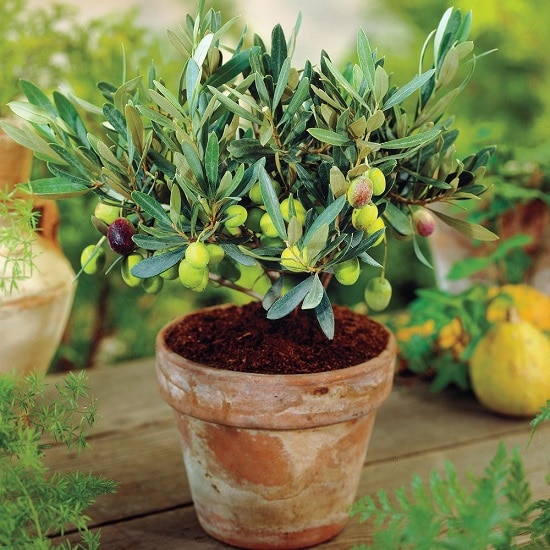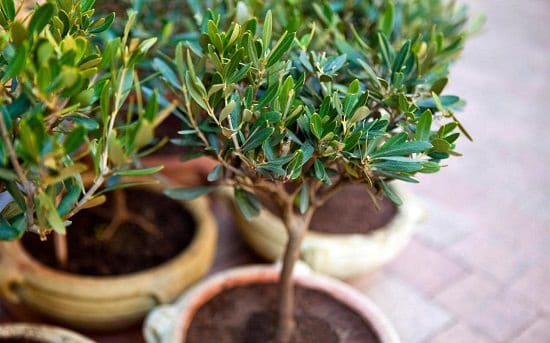Growing Olive Tree in a Pot is a great idea not only for its fruits but the plant’s ornamental looks too. Here’s how to grow them easily!
Growing Olive Tree in a Pot is the best way to accommodate them in a small balcony or patio. As it can grow quite large, having it in a container makes sense if you lack space, and this way, you can also take it with you while moving out!
Check out our article on growing pomegranate tree in pots here
How to Grow Olive Tree in a Pot
The best and the most successful way to grow Olives is to get a plant from a nursery or any trustable online vendor. Dark green foliage indicates a healthy plant.
Best Types of Olives
Here are some of the best types of olives for containers.
- Arbequina Olive: Can reach up to 10-15 feet in height and has the highest concentration of oil in the fruits.
- Frantoio Olive: Grows up to 20-30 feet, but a container-grown tree stays small.
- Mission Olive: Can grow up to 25-30 feet tall in the garden, but in pots, it attains a height of 4-5 feet.
- Picual Olive: The plant can reach 12-18 feet in height. However, a potted specimen stays small.
Best Climate to Grow Olives
Olives love summers, thrive well in hot climates, and grow optimally in zones 9-10. The tree does well in the temperature range of 60-104 F (15-40 C) and might day if exposed to temperature below 25 F (-4 C).
Choosing a Container
A 20-22 inches container would be apt to grow olives. Using pots that are made from clay and wood will serve better as they are “breathable” materials, helping the roots to stay well aerated.
Requirements For Growing Olive Trees
Haven’t planted a tree in a container ever? The olive tree is your best bet! The tree is hardy and easily adaptable when grown in a container. Here are a few things to keep in mind.
Location
Wherever you place it, make sure that your plant is exposed to bright sunlight. For optimum growth, an olive tree relies on at least six hours of direct sun. You won’t even need to provide any afternoon shade in summers as it’s extremely tolerant of heat.
Soil
The olives are used to rocky soil that is not that nutritious, so it doesn’t matter much if the soil is not too fertile. Although, the most critical aspect of selecting the potting soil should be drainage. You can use perlite or lava rocks to the potting mix to improve drainage.
Watering
The worst thing you can do to an olive plant is overwater! Unlike some other plants, olive is not tolerant of overwatering, and letting it sit in soggy soil for a prolonged period can kill it. The perfect watering cycles are the ones in which you allow the soil to dry out in-between. Also, let the excess water to drain freely from the bottom hole of the pots.
Growing Olive Tree Indoors
In zones below 7A move the pot inside during winter season. Place it under artificial light or a bright windowsill and make sure cold drafts of winds do not bother it.
Olives can be moved back outdoors in early springs when the danger of the frost has passed.
Caring for Olive Tree

When it comes to caring, olive is usually care-free after it’s well-established. Still, taking note of a few things will keep potential risks at bay.
Fertilizing
Well-aged compost is enough to keep the soil nutritious. You can fertilize twice in a year during spring and mid-summer if the plant is not growing as expected with an all-purpose fertilizer. Follow the instructions mentioned on the label.
Pruning
In the initial growth stage, the plant does not respond well to pruning, so let it grow undisturbed. After a year, cut back the tips of the branches. It’ll prevent the plant from turning out to be messy. Be creative and trim back the plant according to the length you find will do best in the container. For productive fruiting, leave only three to five main branches unpruned.
Pests and Diseases
Olive plant is most commonly affected by scale infestation when kept indoors. Misting it with a liquid insecticide soap will help to keep scales, ants, and other insects at bay.
Harvesting and Storing
It takes around four to five years for the tree to produce olives, so you need to be patient. Also, they are alternate in fruiting: producing heavy fruits one year and light the next. For table uses, harvest fruits before they turn black. For oil, wait till the outer layer takes a dark shade of brown/black.
You can pickle or can olives for storage. You also have to ‘cure‘ them with brine, water, lye oil, or salt before storing.





I have recently purchased a standard olive tree and need to put it into a larger plant pot. Could you advise as to what is the best type of planting media I should use.
Hi John I am in the same position and probably like you have read a number of articles each with a slightly different spin . I am going for a mix of 20mm gravel , horticultural sand/sharp sand, some chipped bark and a spattering of compost ( still not sure on this in the mix?). Hope this helps? Regards Stephen
Hello Suyash! Thanks for the post. I bought myself a pot with an olive tree about half a year ago, and I’m worried about how it will survive the winter. I usually have it in my garden in the summer, should I put it somewhere warmer, inside the house?